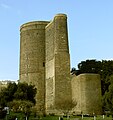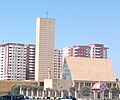Architecture of Azerbaijan
This article includes a list of references, related reading, or external links, but its sources remain unclear because it lacks inline citations. (June 2014) |
| Part of a series on |
| Azerbaijanis |
|---|
| Culture |
| Traditional areas of settlement |
| Diaspora |
| Religion |
| Language |
| Persecution |
Architecture of Azerbaijan (Azerbaijani: Azərbaycan memarlığı) refers to the architecture development in Azerbaijan.
Architecture in Azerbaijan typically combines elements of East and West. Many ancient architectural treasures such as the Maiden Tower and Palace of the Shirvanshahs in the walled city of Baku survive in modern Azerbaijan. Among other medieval architectural treasures reflecting the influence of several schools are the Shirvan shahs' palace in Baku, the Palace of Shaki Khans in the town of Shaki in north-central Azerbaijan, the Surakhany Temple on the Apsheron Peninsula, a number of bridges spanning the Aras River, and several mausoleums. In the nineteenth and early twentieth centuries, little monumental architecture was created, but distinctive residences were built in Baku and elsewhere. Among the most recent architectural monuments, the Baku subways are noted for their lavish decor. The urban planning and architectural activities are regulated by the State Committee for City Building and Architecture of Azerbaijan Republic.
The Shirvanshah Palace
The Shirvanshahs ruled the state of Shirvan in northern Azerbaijan from the 6th to the 16th centuries. Their attention shifted to Baku in the 12th century, when Shirvanshah Manuchehr III ordered that the city be surrounded with walls. In 1191, after a devastating earthquake destroyed the capital city of Shamakhi, the residence of the Shirvanshahs was moved to Baku, and the foundation of the Shirvanshah complex was laid. This complex, built on the highest point of Ichari Shahar, remains as one of the most striking monuments of medieval architecture in Azerbaijan.
The various sections of the Shirvanshah complex were not all created at the same time, and there was not a general plan for the entire complex's construction. Rather, each building was added as the need arose.
Ornamental designs found on the buildings of the Shirvanshah Palace.
Below: Drop-like medallion from the Royal Tomb with the name of the architect, Mohammad Ali, and the word for architect (me'mar) encrypted to be read in the reverse reflection of a mirror.
Much of the construction was done in the 15th century, during the reign of Khalilullah I and his son Farrukh Yassar in 1435-1442.
The buildings that belong to the complex include what may have been living quarters, a mosque, the octagonal-shaped Divankhana (Royal Assembly), a tomb for royal family members, the mausoleum of Seyid Yahya Bakuvi (a famous astronomer of the time) and a bathhouse.
All of these buildings except for the living premises and bathhouse are fairly well preserved. The Shirvanshah complex itself is currently under reconstruction. It has 27 rooms on the first floor and 25 on the second.
The actual original function of the Shirvanshah complex is still under investigation. Though commonly described as a palace, some experts question this. The complex simply doesn't have the royal grandeur and huge spaces normally associated with a palace; for instance, there are no grand entrances for receiving guests or huge royal bedrooms. Most of the rooms seem more suitable for small offices or monks' living quarters.
Divankhana

This unique building, located on the upper level of the grounds, takes on the shape of an octagonal pavilion. The filigree portal entrance is elaborately worked in limestone.
The central inscription with the date of the Assembly's construction and the name of the architect may have been removed after Shah Ismayil Khatai conquered Baku in 1501.
However, there are two very interesting hexagonal medallions on either side of the entrance. Each consists of six rhombuses with very unusual patterns carved in stone. Each elaborate design includes the fundamental tenets of the Shiite faith: "There is no other God but God. Mohammad is his prophet. Ali is the head of the believers." In several rhombuses, the word "Allah" (God) is hewn in reverse so that it can be read in a mirror. It seems looking-glass reflection carvings were quite common in the Oriental world at that time.
Scholars believe that the Divankhana was a mausoleum meant for, or perhaps even used for, Khalilullah I. Its rotunda resembles those found in the mausoleums of Bayandur and Mama-Khatun in Turkey. Also, the small room that precedes the main octagonal hall is a common feature in mausoleums of Shirvan.
The Shirvanshakh Tomb

This building is located in the lower level of the grounds and is known as the Turba (burial vault). An inscription dates the vault to 1435-1436 and says that Khalilullah I built it for his mother Bika khanim and his son Farrukh Yamin. His mother died in 1435 and his son died in 1442, at the age of seven. Ten more tombs were discovered later on; these may have belonged to other members of the Shah's family, including two more sons who died during his own lifetime.
The entrance to the tomb is decorated with stalactite carvings in limestone. One of the most interesting features of this portal is the two drop-shaped medallions on either side of the Koranic inscription. At first, they seem to be only decorative.
The Turba is one of the few areas in the Shirvanshah complex where we actually know the name of the architect who built the structure. In the portal of the burial vault, the name "Me'mar (architect) Ali" is carved into the design, but in reverse, as if reflected in a mirror. Some scholars suggest that if the Shah had discovered that his architect inscribed his own name in a higher position than the Shah's, he would have been severely punished. The mirror effect was introduced so that he could leave his name for posterity.
Remnants of history
Another important section of the grounds is the mosque. According to complicated inscriptions on its minaret, Khalilullah I ordered its construction in 1441. This minaret is 22 meters in height (approximately 66 feet). Key Gubad Mosque, which is just a few meters outside the complex, was built in the 13th century. It was destroyed in 1918 in a fire; only the bases of its walls and columns remain. Nearby is the 15th-century Mausoleum, which is said to be the burial place of court astronomer Seyid Yahya Bakuvi.
Murad's Gate was a later addition to the complex. An inscription on the gate tells that it was built by a Baku citizen named Baba Rajab during the rule of Turkish sultan Murad III in 1586. It apparently served as a gateway to a building, but it is not known what kind of building it was or even if it ever existed.
In the 19th century, the complex was used as an arms depot. Walls were added around its perimeter, with narrow slits hewn out of the rock so that weapons could be fired from them. These anachronistic details don't bear much connection to the Shirvanshahs, but they do hint at how the buildings have managed to survive the political vicissitudes brought on by history.
In the courtyard can be seen some of the carved stones from the friezes that were brought up from the ruined Sabayil fortress that lies submerged underwater off Baku's shore. The stones have carved writing that records the genealogy of the Shirvanshahs.
The complex was designated as a historical site in 1920, and reconstruction has continued off and on ever since that time. According to Sevda Dadashova, Director, restoration is currently progressing, though much slower than desired because of a lack of funding.
Palaces
-
Palace of Nakhchivan Khans, Nakhchivan
Mosques
Castles and fortresses
Skyscrapers and highrises
In the end of 1990-es the highrise buildings abundantly appeared in Baku, the capital city of Azerbaijan. The most eminent buildings are "Flame Towers", "Port Baku Towers", "Trump tower", "Azure". "SOCAR Tower" and "The Crescent Development project" are under construction and planned to be the highest after completion.
Gallery
-
Maiden Tower in Baku.
-
Dadivank monastery.
-
Ortodox Church of Saint Michael Archangel in Baku
-
Ortodox Holy Myrrhbearers Cathedral
-
Dome of the Bibi-Heybat Mosque
-
National Art Museum of Azerbaijan (De Bur's Palace).
-
Ismailiyya Palace in Baku.
-
Seyid Mirbabayev's Palace in Baku.
-
Government House in Neftchilar Avenue, Baku.
See also
References
Seyran Valiyev and Fuad Akhundov both contributed to this article. The book "Baku" by Leonid Bretanskiy was also referenced (Iskusstvo (Art) Publishing House: Leningrad, Moscow, 1970).



































